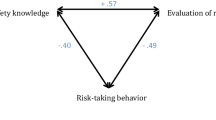Abstract
Although safety rules are one of the primary preventative tactics used by parents to avoid childhood injury, very little is known about how rules are applied within families. In this preliminary study in the area of application of family safety rules, we found that mothers tended to impose rules consistently more often than inconsistently, and where they were inconsistent, they tended to regard a risky behavior as unacceptable, even if there was no family rule outlawing the behavior. The number of rules was negatively related to the number of injuries, suggesting that rules may indeed have the preventative properties that parents believe them to have. The importance of understanding how rules may prevent or fail to prevent injuries is underlined and future research challenges are described.
Similar content being viewed by others
References
Baker, S. P., and Waller, A. E. (1989).Childhood injury: State-by-state mortality facts. John Hopkins University School of Public Health, Baltimore, MD.
Butler, J. A., and Mitrovich, K. A. (1987). The Select Panel for the Promotion of Child Health: Injury recommendations in retrospect.J. Soc. Issues 43: 119–132.
Garbarino, J. (1988). Preventing childhood injury: Developmental and mental health issues.Am. J. Orthopsychia. 58: 25–45.
Gralinski, J. H., and Kopp, C. B. (1993). Everyday rules for behavior: Mother's requests to young children.Dev. Psychol. 29: 573–584.
Hauser, R. M., and Featherman, D. L. (1977).The Process of Stratification: Trends and Analyses, Academic Press, New York.
Hollingshead, A. B., and Redlich, F. C. (1958).Social Class and Mental Illness, Wiley, New York.
Langley, J., and Silva, P. (1982). Childhood accidents—Parents' attitudes to prevention.Austral. Paediat. J. 18: 247–249.
Masters, M. (1978).Revised Statutes of the State of Missouri 4: 4707.
National Committee for Injury Prevention and Control (1989).Injury Prevention: Meeting the Challenge. Oxford University Press, New York.
Peterson, L., and Roberts, M. C. (1992). Complacency, misdirection, and effective prevention of children's injuries.Am. Psychol. 47: 1040–1044.
Peterson, L., and Schick, B. (1993). Empirically derived injury prevention rules.J. Appl. Behav. Anal. 26: 451–460.
Peterson, L., Mori, L., and Scissors, C. (1986). Mom or dad says I shouldn't: Supervised and unsupervised children's knowledge of their parents' rules for home safety.J. Pediat. Psychol. 11: 177–188.
Peterson, L., Farmer, J., and Kashani, J. H. (1990). Parental injury prevention endeavors: A function of health beliefs?Health Psychol. 9: 177–191.
Peterson, L., Harbeck, C., and Moreno, A. (1993). Measures of children's injuries: Self-reported versus maternal-reported events with temporally proximal versus delayed reporting.J. Pediat. Psychol. 18: 133–147.
Peterson, L., Bartelstone, J., Kern, T., and Gillies, R. (1995). Parent's socialization of children's injury prevention: Description and some initial parameters.Child Dev. 66: 224–235.
Peterson, L., Brown, D., Bartelstone, J., and Kern, T. (1996). Methodological considerations in participant even monitoring of low baserate events: Children's injuries as a model.Health Psychol. 15: 124–130.
Pless, I. B., and Arsenault, L. (1987). The role of health education in the prevention of injuries to children.J. Soc. Issues 43: 87–104.
Power, T. G., and Chapieski, M. L. (1986). Childrearing and impulse control in toddlers: A naturalistic investigation.Dev. Psychol. 22: 271–275.
Rivara, F. P., and Mueller, B. A. (1987). The epidemiology and causes of childhood injuries.J. Soc. Issues 43: 13–31.
Rivara, F. P., Calonge, N., and Thompson, R. S. (1989). Population-based study of unintentional injury incidence and impact during childhood.Am. J. Public Health 79: 990–994.
Rodriguez, J. G. (1990). Childhood injuries in the United States: A priority issue.Am. J. Dis. Child. 144: 625–626.
Scheidt, P. C. (1988). Behavioral research toward prevention of childhood injury.Am. J. Dis. Child. 142: 612–617.
Spiegel, C. N., and Lindaman, F. C. (1977). Children can't fly: A program to prevent childhood morbidity and mortality from window falls.Am. J. Public Health 67: 1143–1147.
Wortel, E., and de Geus, G. H. (1993). Prevention of home related injuries of pre-school children: Safety measures taken by mothers.Health Educ. Res. 8: 217–231.
Author information
Authors and Affiliations
Rights and permissions
About this article
Cite this article
Peterson, L., Saldana, L. Accelerating children's risk for injury: Mothers' decisions regarding common safety rules. J Behav Med 19, 317–331 (1996). https://doi.org/10.1007/BF01904759
Accepted:
Issue Date:
DOI: https://doi.org/10.1007/BF01904759



